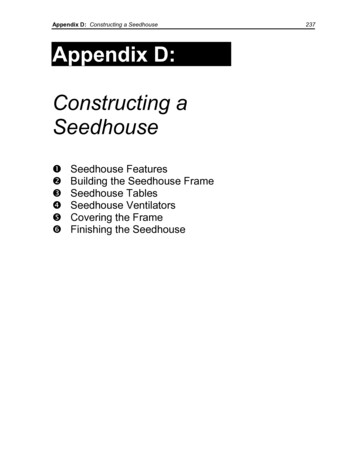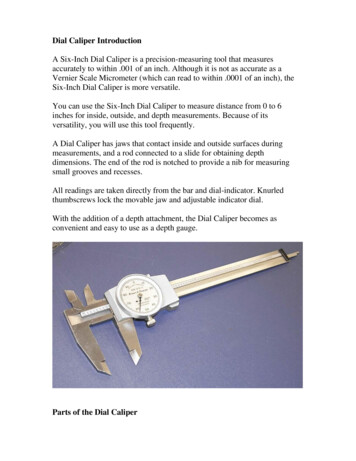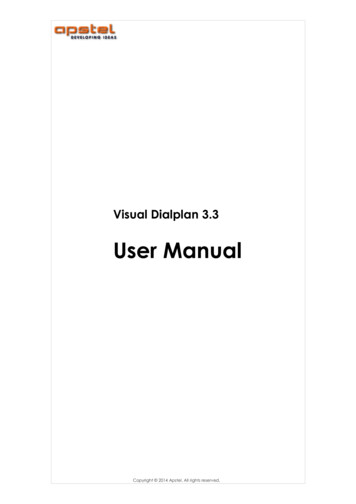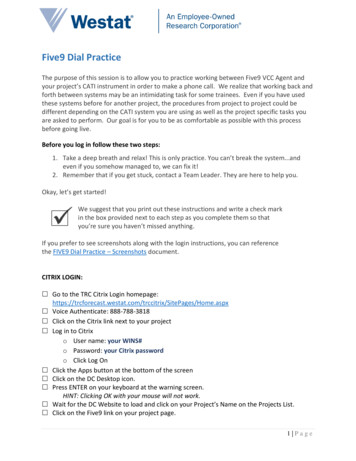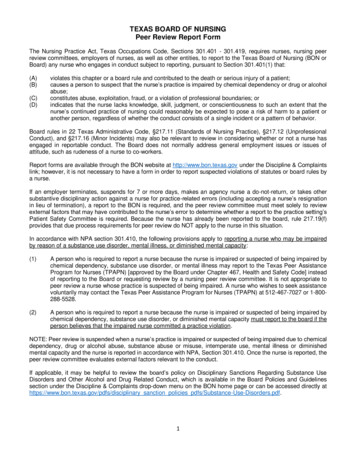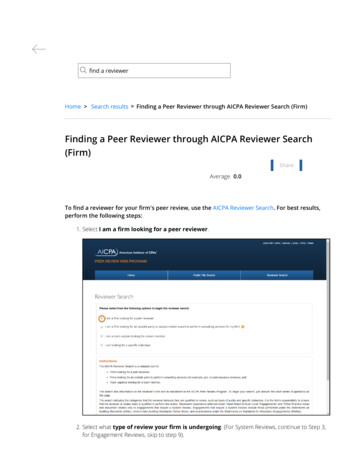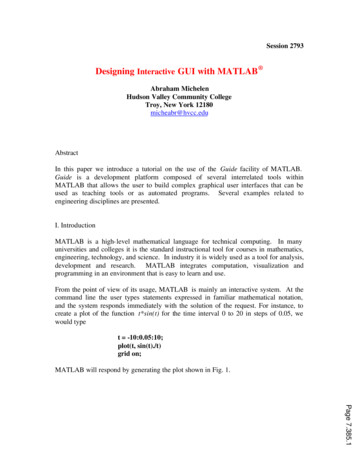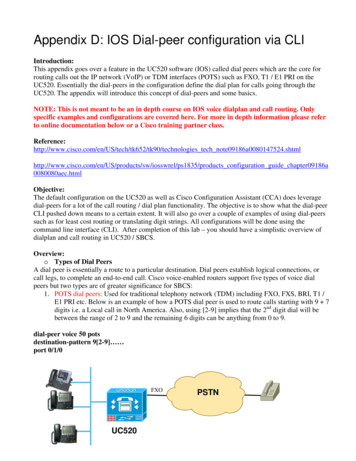
Transcription
Appendix D: IOS Dial-peer configuration via CLIIntroduction:This appendix goes over a feature in the UC520 software (IOS) called dial peers which are the core forrouting calls out the IP network (VoIP) or TDM interfaces (POTS) such as FXO, T1 / E1 PRI on theUC520. Essentially the dial-peers in the configuration define the dial plan for calls going through theUC520. The appendix will introduce this concept of dial-peers and some basics.NOTE: This is not meant to be an in depth course on IOS voice dialplan and call routing. Onlyspecific examples and configurations are covered here. For more in depth information please referto online documentation below or a Cisco training partner 652/tk90/technologies tech US/products/sw/iosswrel/ps1835/products configuration guide chapter09186a0080080aec.htmlObjective:The default configuration on the UC520 as well as Cisco Configuration Assistant (CCA) does leveragedial-peers for a lot of the call routing / dial plan functionality. The objective is to show what the dial-peerCLI pushed down means to a certain extent. It will also go over a couple of examples of using dial-peerssuch as for least cost routing or translating digit strings. All configurations will be done using thecommand line interface (CLI). After completion of this lab – you should have a simplistic overview ofdialplan and call routing in UC520 / SBCS.Overview:o Types of Dial PeersA dial peer is essentially a route to a particular destination. Dial peers establish logical connections, orcall legs, to complete an end-to-end call. Cisco voice-enabled routers support five types of voice dialpeers but two types are of greater significance for SBCS:1. POTS dial peers: Used for traditional telephony network (TDM) including FXO, FXS, BRI, T1 /E1 PRI etc. Below is an example of how a POTS dial peer is used to route calls starting with 9 7digits i.e. a Local call in North America. Also, using [2-9] implies that the 2nd digit dial will bebetween the range of 2 to 9 and the remaining 6 digits can be anything from 0 to 9.dial-peer voice 50 potsdestination-pattern 9[2-9] port 0/1/0FXOUC520PSTN
2. VoIP dial peers: Used for routing calls over the IP network to an IP address or DNS hostname.The 2 main VoIP protocols used are H.323 (default) or SIP (recommended). Typical examples foruses of VoIP dial-peers in UC520 are to route calls to voicemail / AA (via CUE), route calls overa SIP trunk to a provider or inter site dialing (as shown in Lab #6). Below is an example of a dialpeer on the Odd pod to route calls to the even pod using 82xxx.dial-peer voice 10000 voipdestination-pattern 82 session protocol sipv2 ÅUsing SIP as VOIP protocolcodec g711ulaw Å Using G711 as the VOIP codecsession target ipv4:10.10.10.2 Å Defines IP address to send VOIP call tono vaddtmf-relay rtp-nteOdd PODEven PODUC520UC520IP Networko Outbound Dial-peer matching patternsDial-peers route on the value after the destination-pattern CLI under each dial-peer. Common destinationpattern wildcards arePatternExplanationDigits such as 0-9,*,# Digits one would dial on a phonePeriod or dot (.)Specifies any one wildcard digitComma (,)Inserts a one-second pauseSquare brackets [x-y] Indicates a range of digits within the bracketsPercentage (%)The preceding digit occurred zero or more timesTIndicates a variable-length patternFor the North American dial-plan, here is a typical example of what you would haveLocal 7-digit dialing Æ destination-pattern 9[2-9].Long Distance 11-digit “1 ” dialing Æ destination-pattern 91[2-9].[2-9].International dialing Æ destination-pattern 9011TEmergency or 911 Æ destination-pattern 9911Cisco Unified Communications Technical TrainingPage 2 of 6
Here is another exercise showing how dial-peer matching occurs based on the below config:o Least Cost routingOutbound dial-peer matching is primarily based on the called-number matching the destination-pattern asshown above. However in case the destination-pattern is EXACTLY the same, then the tie breaker used issomething known as preference that is configured under the dial-peer. The lower the preference, thehigher the priority of that dial-peer getting chosen.In the below example, let us assume that a customer has a primary route of the SIP trunk for long distancecalls, in the event that the SIP trunk is down, they want to route calls over a backup analog line on FXOport 0/1/0.dial-peer voice 1001 voipdescription SIP Trunk dial-peer for Long Distancedestination-pattern 91[2-9].[2-9] session protocol sipv2codec g711ulawsession target dns:sipconnect.cisco.comno vaddtmf-relay rtp-ntetranslation-profile outgoing PSTN!dial-peer voice 50 potsdescription Backup FXO dial-peer for Long Distancedestination-pattern 91[2-9].[2-9] preference 5port 0/1/0!Cisco Unified Communications Technical TrainingPage 3 of 6
The default preference is “0” (default CLIs will NOT show up in the config) and hence the primary routechosen is the SIP trunk dial-peer versus the FXO dial peer.o Class of Restrictions (COR)COR provides a way to deny certain calls based upon the incoming and outgoing settings on dial peersand ephone-dns. Each dial peer and ephone-dn can have one incoming COR and one outgoing COR.The incoming COR list indicates the capacity of the dial peer to initiate certain classes of calls.The outgoing COR list indicates the capacity required for an incoming dial peer to deliver a call via thisoutgoing dial peer.PSTNIncomingCOR Listdial-peer cor list userdomesticmember internalmember localmember domesticIncomingEphone-dnephone-dn 11number 102cor incoming userdomesticOutgoing Dial-peerdial-peer 53 voice potscorlist outgoing calldomesticdestination-pattern91Call Allowed: Member domestic Matchesfor Incoming and Outgoing COR ListCall Blocked: No Member Match forIncoming and Outgoing COR ListBLOCKOutgoingCOR ListDial-peer cor listcall-domesticDial-peer cor listcall-internatonaldial-peer cor customname internalname localname domesticname internationalname 900name 976!dial-peer cor list call-domesticmember domestic!dial-peer cor list user-domesticmember internalmember localmember domestic!dial-peer voice 53 potscorlist outgoing call-domesticdescription ** FXO pots dial-peer **preference 1Cisco Unified Communications Technical TrainingPage 4 of 6
destination-pattern 91.port 0/1/0prefix 1!ephone-dn 11 dual-linenumber 102corlist incoming user-domesticReference for further tk90/technologies configuration example09186a008019d649.shtmlo Using Translation rulesThe UC500 allows for digit manipulation via a feature known as Voice Translation rules. The digitmanipulation can be applied to called numbers or calling numbers (caller ID) and can be applied when thecall is received or sent out to another destination by the UC500. For example, in Lab 6 during the intersite dial-plan an example was shown on how to setup inter site dialing with 5 digits – on each UC500digit translation was done translate the called number from 5 digits to the 3 digit extension local to theUC500. The translation rules are typically applied on the basis of matching a given digit string and thenmanipulating that. This digit string & manipulation uses wildcard matching via regular expressions.In the below example – the intent is to manipulate all caller ID going out the SIP trunk to match the mainnumber (eg 408 555 1200):1. Define the match pattern and digits that this should be manipulated to:voice translation-rule 1111rule 1 / .*/ /4085551200/2. Define what is being manipulated (meaning called or calling number)voice translation-profile PSTN Outgoingtranslate calling 11113. Apply the profile to the outbound dial-peer in this case – it’s the SIP Trunk dial-peer:dial-peer voice 1001 voiptranslation-profile outgoing PSTN OutgoingAnother example would be converting the main number to the internal AA extension. In this examplethe inbound call comes in on a T1 PRI trunk as 4085551200 and the internal AA is 4001. Define the match pattern and digits that this should be manipulated to:voice translation-rule 2001rule 1 /4085551200/ /400/2. Define what is being manipulated (meaning called or calling number)voice translation-profile AA Profiletranslate called 20013. Apply the profile to the inbound dial-peer in this case – it’s the POTS dial-peer:dial-peer voice 100 potsCisco Unified Communications Technical TrainingPage 5 of 6
incoming called-number 4085551200translation-profile incoming AA Profiledirect-inward-dialMore complex examples are nologies tech note09186a0080325e8e.shtmlCisco Unified Communications Technical TrainingPage 6 of 6
a SIP trunk to a provider or inter site dialing (as shown in Lab #6). Below is an example of a dial-peer on the Odd pod to route calls to the even pod using 82xxx. dial-peer voice 10000 voip . destination-pattern 82 session protocol sipv2 ÅUsing SIP as VOIP protocol . codec g711ulaw Å Using G711 as the

